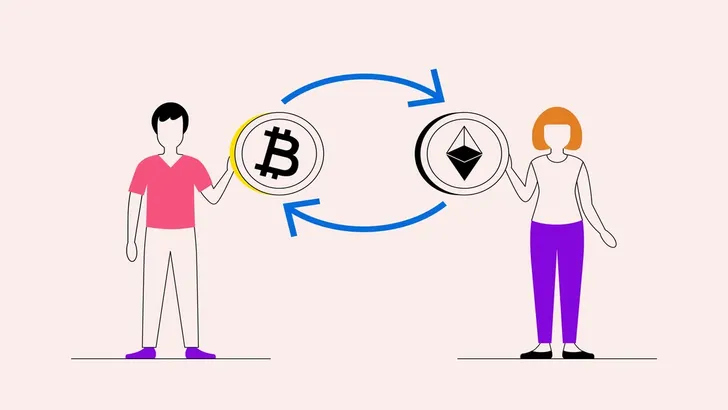What Is Atomic Swap? Importance, Advantages & Disadvantages

crypto basics
One of the biggest perks of the realm of cryptocurrencies is constant innovation and the emergence of new technologies that make the space better. A term that’s been making waves in recent times and sparking interest among experienced traders and entry-level crypto participants alike is atomic swap.
Then again, there are individuals who have been navigating the cryptosphere for a while, yet they still haven’t heard of the atomic swap. So, what exactly does it mean, and why is it gaining so much traction in the community? Better yet, is it important to you as an eager investor, and what are its benefits and drawbacks?
As the world of decentralized finance keeps decentralizing, peer-to-peer transactions are becoming its fundamental aspect. So, let’s figure out how the atomic swap fits into the narrative and what advantages it brings to the table.
What Is an Atomic Swap?

Atomic swap refers to a peer-to-peer exchange of cryptocurrencies, even when they are on different blockchains. It is also known as a “cross-chain swap,” as it allows the trading of coins and tokens from incompatible networks without the assistance of any sort of intermediary.
That means users are able to “atomic swap” Bitcoin for Litecoin (along with any other combination of cryptocurrencies) without paying any fees or placing trust in third parties to govern the process. The process got its name from the concept of the atomic state—a state that has no substates. Simply put, crypto atomic swaps either happen or they don’t.
The main reason for this is that atomic swaps are powered by smart contracts. These pieces of code were created to ensure the exchange only happens if both parties fulfill their end of the deal. This approach minimizes the risk of malicious activities by either party.
The History of Atomic Swaps
The history of atomic swaps is almost as old as cryptocurrency itself. The need for cross-chain trading appeared with the rise in popularity of altcoins from different blockchains, which people wanted to trade with Bitcoin and among themselves.
The concept of an atomic swap was first described by Tier Nolan in 2013 on the BitcoinTalk forum. However, a similar idea was already discussed in 2012 when Daniel Larimer came up with a protocol for trustless swapping, which many consider to be the precursor to atomic swap.
The first atomic swap occurred in 2017, when Litecoin founder, Charlie Lee, tweeted that he successfully exchanged LTC for BTC. Since then, the process has been improved to increase interoperability among numerous blockchains. The goal is to create a promising alternative to established ways of trading cryptocurrencies.
How Do Atomic Swaps Work?
Atomic swaps work using a specially designed smart contract called a hashed timelock contract (HTLC).
At their core, smart contracts are programmable and self-executing, and they trigger when the conditions—which are written into the contract—are met. They represent the foundation of the realm of decentralized finance, allowing for various functionalities without the need for a governing third party.
A hashed timelock contract is designed to have two core functionalities:
- The timelock key gives HTLC properties of a “virtual timed vault.” It uses cryptography to keep the funds locked up and safe for a limited time until both parties agree to a swap. If any party fails to confirm the transaction within a designated time period, the funds are returned to both senders, and the transaction fails.
- The hashlock key ensures the security of the transaction. When someone initiates an atomic swap, HTLC encrypts the process, locks up the funds, and gives the participant an encrypted number—a hash. The same event occurs on the other end. After that, the two parties use their encrypted numbers to unlock the funds and facilitate a trade.
One of the key advantages atomic swaps have over decentralized exchanges is the level of control over the assets and the entire transaction. While using an atomic swap, users are in possession of their private keys the whole time. As a result, atomic swaps are fully decentralized, peer-to-peer exchanging processes.
Another upside is cross-chain interoperability. Most DEXs operate on a specific network, and trading between blockchains is usually done through bridging. On the other hand, atomic swaps allow for seamless asset exchanges between completely different blockchains.
Atomic Swap Process
Let’s take a step-by-step look at the atomic swap process to better understand how it occurs:
- Starting the swap. Two users agree to use an atomic swap to exchange cryptocurrency, so they create an HTLC that will expire in a set amount of time.
- Initiation by the first party. One of the users initiates the swap by locking up the amount of cryptocurrency they want to trade. This gives them a private key, which they use to generate its cryptographic hash and send it to the other user.
- Counterparty action. The other party can use the received hash to verify if the funds are locked up, but they can’t access them. They then use that hash to lock their funds at a new address under the same contract.
- Claiming funds. The first user is then able to see and claim funds deposited by the second one. When they do that, their private key is also revealed, and both participants can claim their funds.
- Completion. If both parties agree to claim their funds, the transaction is complete. However, if any of the two fail to complete a transaction, the funds are reverted back to the original owners.
The Importance of Atomic Swaps
The importance of atomic swaps is the role they play in the ever-evolving blockchain ecosystem. First off, they are directly related to some of the key concepts of the crypto world, such as decentralization and autonomy.
While the whole purpose behind the cryptocurrency movement was to create a system independent of centralized banking, centralization risks are still present. Traditional, centralized crypto exchanges come with those risks and involve governing authorities, which stands against the core principles of cryptocurrency.
On the other hand, atomic swaps facilitate true peer-to-peer value exchange, like the one Satoshi Nakamoto envisioned in their Bitcoin whitepaper. Users maintain control of their private keys at all times, preserving the decentralization ethos of the crypto world.
Interoperability is the feature that ties the whole ecosystem together. After altcoins were invented to overcome some of the drawbacks of Bitcoin, cross-chain transactions emerged as a new issue. The ability to seamlessly transfer value between blockchains, thus effortlessly integrating the entire cryptosphere, is one of the biggest advantages of atomic swaps.
Finally, there are the perks of reduced costs and enhanced security while using atomic swaps. Since these swaps forego the need for middlemen, there are no fees associated with them either. Moreover, any risks associated with centralized intermediaries are removed, and reliance on smart contracts greatly reduces any chance of hacks and fraud.
Atomic Swap Example
Let’s check out an example of an atomic swap to better understand how the process works in reality. Imagine we have two cryptocurrency participants, where User A wants to trade 1 BTC for 50 LTC with User B. Here’s how they can do it:
- User A and User B create an HTLC with a one-hour timer.
- User A deposits their 1 BTC to a created contract address, to which they get a private key. They use that private key to create a hash and send it to User B.
- User B can use the hash they received to verify that User A deposited 1 BTC, but they still can’t withdraw it.
- Using the obtained hash, User B deposits their 50 LTC to a new address. Now both parties have their funds locked in an HTLC smart contract.
- Since User B deposited their 50 LTC with User A’s hash, User A can now see and withdraw 50 LTC.
- When User A withdraws 50 LTC, their private key is revealed to User B, who can then withdraw 1 BTC.
- After both parties have claimed their funds, the swap is complete, and the process cannot be reversed.
If the process isn’t completed within a set timeframe or if any party fails to claim funds, the transaction is reverted and assets are returned to their original owners.
Advantages of Atomic Swaps

Atomic swaps bring numerous benefits to the world of cryptocurrencies. Some of the most important ones include:
- True decentralization. Atomic swaps represent the epitome of decentralization, which underpins the entire cryptocurrency ecosystem. They enable direct peer-to-peer digital currency transfers, regardless of the blockchain. There are no governing authorities, as everything is handled by programmable smart contracts.
- Cross-chain interoperability. With more than 1,000 different blockchains out there, it can be challenging to connect them all and allow transactions between them. Atomic swaps bridge these distinct blockchains and enable fluid exchanges, thus promoting a stronger and more cohesive DeFi ecosystem.
- Improved security. Hashed timelock contracts are built with several fail-safe mechanisms included. They drastically reduce the chances of anyone manipulating the system and committing fraud. Furthermore, they remove the need for centralized exchanges, which are prone to various attacks.
- Reduced costs. Centralized exchanges usually charge fees for trading and transacting on them. Since atomic swaps bypass intermediaries through smart contracts, the resulting transaction costs are generally reduced.
- Privacy and autonomy. Most centralized exchanges and many custodial wallets require users to perform KYC (Know Your Customer) to use them. Privacy-concerned crypto enthusiasts can use atomic swaps to trade crypto while avoiding giving their private information to third parties.
- Enhanced liquidity. The ability to trade assets regardless of blockchain can lead to improved liquidity in the crypto market. Traders are no longer restrained by networks, which makes their holdings more liquid.
Disadvantages of Atomic Swaps
Atomic swaps aren’t without drawbacks, so familiarizing yourself with their disadvantages can be essential to using them properly. Here are some of the most prominent ones:
- Complexity. The realm of cryptocurrency already features a steep learning curve and already requires knowledge to navigate properly. Atomic swaps require further familiarity with concepts such as timelocks, hashes, and transaction periods. These can deter the average user and prolong the mainstream adoption period.
- Partial compatibility. While cross-chain compatibility is one of the key perks of atomic swaps, it is not yet fully realized. Transactions still can’t be done across all networks, but only those that use the same hashing algorithms.
- Specific requirements. Crypto holders need to use specific services or wallets for atomic swaps. Since the process is still in development, its hardware and software support are still limited.
- No intermediary oversight. While the removal of governing authorities is generally considered a benefit, it’s not without drawbacks. It means there is no third party to govern any disputes and handle any conflicts that may arise during the exchange process.
Atomic Swap vs. Bridge
Atomic swap shares some similarities with crypto bridges, such as:
- Interoperability. Both concepts aim to connect blockchains and facilitate asset transfers between them
- Decentralization. Just like atomic swaps, many bridges rely on smart contracts to transfer assets between different networks.
That’s where most similarities end. Atomic swap and crypto bridging are still vastly different, with some of the key differences being:
- Mechanism. Atomic swaps facilitate peer-to-peer crypto exchange between two different pairs and two different blockchains. Bridging allows crypto assets from one network to be used on another. This process usually involves locking up original assets and minting pegged assets on the other blockchain.
- Use case. The purpose of atomic swap is to exchange values between different users (e.g., one user can atomic swap Monero for the other user’s Ethereum). Bridging allows a user to move their assets to another network, often for increased functionality.
- Finality. Atomic swaps are final, and if users want to trade back, they need to both agree to another exchange and initiate it again. On the other hand, bridging is temporary, and the holder can always bridge their coins or tokens back to the original network.
Key Takeaways
The world of cryptocurrency, at its core, is built with decentralization in mind. Its fast-evolving nature caused many elements from the realm of traditional finance (such as centralization) to creep in.
In that environment, an atomic swap might represent the turning point that brings the system back on track. With its promise of privacy, security, interoperability, and autonomy, atomic swap stands as a beacon of decentralization in the cryptosphere.
While the road ahead isn’t without challenges, the promise of a future of interconnected networks pushes research in the right direction and places atomic swaps at its forefront.